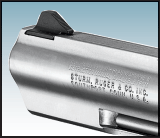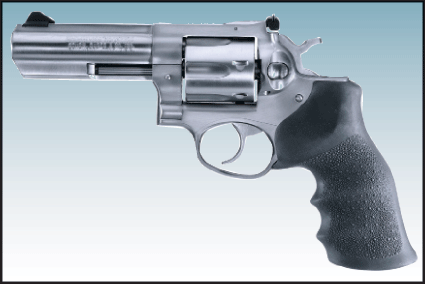Certain guns just seem to roll on forever. This one hasn’t been riding along in Yankee holsters for all that long, but it has all the qualities that have made other guns classics. It’s strong, powerful, easy to use, and durable in the extreme degree. But above all else, Ruger’s GP100 is accurate well beyond the norm for revolvers of this class and price. As an avid Smith & Wesson revolver man, I had to keep my love affair with the Ruger GP100 out of the public view for two decades and then some, but I assure you that it started when I Ransom Rested the one you see here. That was in ‘85 or early ‘86.
 Ruger introduced the GP100 in 1985, but it was not their first DA/SA revolver. Back in 1972, the automatic pistol had yet to take over the police and personal defense markets. Revolvers with the typical twin trigger functions—cocking the hammer with the trigger, called double-action or cocking it with the thumb, known as single-action—were viable products. S&W dominated the market with fighting revolvers made on three frames, with Colt in second place. Ruger saw the potential here, particularly in the light of their well-developed investment casting process.
Ruger introduced the GP100 in 1985, but it was not their first DA/SA revolver. Back in 1972, the automatic pistol had yet to take over the police and personal defense markets. Revolvers with the typical twin trigger functions—cocking the hammer with the trigger, called double-action or cocking it with the thumb, known as single-action—were viable products. S&W dominated the market with fighting revolvers made on three frames, with Colt in second place. Ruger saw the potential here, particularly in the light of their well-developed investment casting process.
In ’72, they came out with the radically different Security Six series of DA/SA revolvers. Eventually this series included fixed sight Service Sixes and short-barreled Speed Sixes. All were based on the same rugged frame. Priced very competitively with the S&Ws and Colts, these new revolvers came to be respected for their quality.
Advertisement — Continue Reading Below
Gun Details
But Ruger was getting into the DA/SA revolver big time and developed some innovations that really demanded a completely new gun. Thus, the GP100 revolver was born, a lineal descendant of the Security-Six series of guns, but vastly improved in both strength and features. It is a medium-frame, six-shot .357 Mag revolver with adjustable sights and a unique butt section. The GP100 does not have a frame with a distinctive butt contour onto which grip plates of wood or rubber are attached. Instead, there is a grip tang that is integral with the frame. It extends down and away at an angle from the rest of the frame. Much smaller than most grip frames, the tang accepts a slide-on, one-piece rubber grip that is held in place with a screw running through ornamental grip plates. The small tang gives the grip makers plenty of room to do their thing, but I have actually seen very few GP100s with custom grips. I have a pair made by the late Deacon Deeson and they look and work great. Most GP100 shooters seem to stay with the issued grip, which has a very functional shape.
RELATED: Wiley Clapp Ruger .357 Mag Revolver Review
The frame of the GP100 is made in one single piece of stainless steel, cast by the investment casting process. This is an ingenious system that permits the maker to produce complicated shapes with virtually no machining. Ruger has made an art out of the so-called “lost wax” method, realizing from the outset that there were major economic and structural advantages to using it. On the GP100 revolver, there is no sideplate in the style of contemporary Colt and S&W revolvers. The lockwork is ultra simple and comes out when the triggerguard is removed. In the GP100 design, the rod on which the cylinder appears to turn is really nothing more than a convenient handle to extract empties. It isn’t even centrally mounted in the cylinder. Since the gun is chambered for powerful magnum cartridges, it has to be strong. It was engineered for the new breed of hot .357 ammo, which has been known to raise hell with thin points in other makes of revolvers. GP100s have an extra thick barrel shank and cylinder stop notches that are not directly over charge holes. Even the cylinder lock is different. Locked at the rear with a plunger from the cylinder going into the standing breech, the gun has another lock at the front of the crane. It is in the form of a pivoting latch that snaps into a recess in the frame. It clears with pressure on the thumb latch on the left side of the revoler. This part is likewise unique. Rather than a latch that presses forward or pulls back, the Ruger GP100’s pivots inward. It is completely out of the way and directly behind the axis of the revolver’s cylinder.
Advertisement — Continue Reading Below
Shooter amenities abound. The rear sight is sturdy and click adjustable for both windage and elevation. The front sight is a snap-in, snap-out type that could give a shooter the option of changing sights for the conditions. The colored polymer inserts made for the Redhawk revolver will fit in the GP100, but they are too high. I have shortened them for use in the GP100 and it works perfectly. Just handling the GP100 gives the impression of solid quality and ruggedness. Everything is strong and well made. Most models have a barrel with full-length underlug, which gives the gun a desirable muzzle-heavy heft. The trigger pull is on the heavy side, but relatively smooth. The action responds well to the attention of a competent pistolsmith. It is just an all-around fine revolver.
Check out these 14 Formidable .357 Magnum Revolvers!
Range Time
That is, until you take one to the range, at which time it displays accuracy at a level that is hard to explain. I once did a survey article with four different GP100s, firing them with four different kinds of commercial ammo at 25 yards. I went twice around the cylinder with each load in each gun, 12 rounds. I used the Ransom Rest and the guns averaged 1.57 inches overall. On other occasions after that, I had occasion to shoot ten more GP100s. Every last one of them would produce at least one 12-shot group that was one hole and under 2 inches. More often than not, the average group size was right at 1.5 inches and that is with a wide variety of ammunition. With carefully tuned handloads, I have seen a dozen shots close to 0.50 of an inch. The GP100 revolver is exceptionally accurate. I have personally Ransom Rested 14 different guns over the years and they all shoot this way.
Advertisement — Continue Reading Below
Since its introduction in ‘85, a lot has happened in the world of fighting firearms. At that point in history, about half the nation’s cops were carrying wheelguns. You would have to look hard to find a department that issues them today, so the GP100 is a classic case of too late. It is a magnificent firearm in the performance sense, but when the company also makes guns like the 17+1 SR9 9mm autopistol, an old-fashioned 6-shot .357 Mag just isn’t going to make it. Over the quarter-century of production, the GP100 was made in both blue and stainless versions, with 3-, 4- and 6-inch barrels, both heavy and light. I found out that there was also a short run of 5-inchers made for Davidson’s. The 3-inch GP100 came with fixed sights and either a short or long underlug. I had them, too. They shoot like they wanted to go to Camp Perry. The GP100 is a great Yankee firearm that goes unappreciated in a world gone mad over volume of fire.
There is one more quality that I haven’t mentioned. In all those shoots where I was Ransom Resting one GP100 or another, I was also chronographing them. With no exceptions, the GP100 in any barrel length will get a little more velocity than a comparable Colt, Smith, Taurus, Wesson, or Rossi. I can speculate as to why but I don’t really know for sure.
For more information visit www.ruger.com.
Advertisement — Continue Reading Below
























